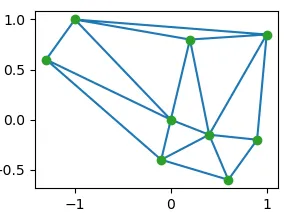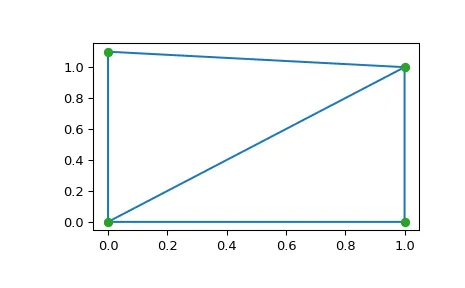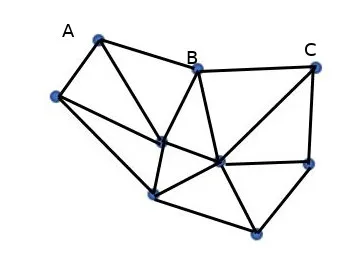3个回答
5
你可以使用scipy.spatial.Delaunay。以下是来自文档的示例:
如果您想知道哪些顶点是连接的,那么还有一个包含该信息的属性:
import numpy as np
points = np.array([[-1,1],[-1.3, .6],[0,0],[.2,.8],[1,.85],[-.1,-.4],[.4,-.15],[.6,-.6],[.9,-.2]])
from scipy.spatial import Delaunay
tri = Delaunay(points)
import matplotlib.pyplot as plt
plt.triplot(points[:,0], points[:,1], tri.simplices)
plt.plot(points[:,0], points[:,1], 'o')
plt.show()
这是类似于您输入的结果:
三角形存储在Delaunay对象的simplices属性中,该属性引用了points属性中存储的坐标:
>>> tri.points
array([[-1. , 1. ],
[-1.3 , 0.6 ],
[ 0. , 0. ],
[ 0.2 , 0.8 ],
[ 1. , 0.85],
[-0.1 , -0.4 ],
[ 0.4 , -0.15],
[ 0.6 , -0.6 ],
[ 0.9 , -0.2 ]])
>>> tri.simplices
array([[5, 2, 1],
[0, 3, 4],
[2, 0, 1],
[3, 0, 2],
[8, 6, 7],
[6, 5, 7],
[5, 6, 2],
[6, 3, 2],
[3, 6, 4],
[6, 8, 4]], dtype=int32)
如果您想知道哪些顶点是连接的,那么还有一个包含该信息的属性:
>>> tri.vertex_neighbor_vertices
(array([ 0, 4, 7, 12, 16, 20, 24, 30, 33, 36], dtype=int32), array([3, 4, 2, 1, 5, 2, 0, 5, 1, 0, 3, 6, 0, 4, 2, 6, 0, 3, 6, 8, 2, 1,
6, 7, 8, 7, 5, 2, 3, 4, 8, 6, 5, 6, 7, 4], dtype=int32))
- Alex
3
您可以尝试使用scipy.spatial.Delaunay。请参考该链接:
points = np.array([[0, 0], [0, 1.1], [1, 0], [1, 1]])
from scipy.spatial import Delaunay
tri = Delaunay(points)
plt.triplot(points[:,0], points[:,1], tri.simplices)
plt.plot(points[:,0], points[:,1], 'o')
plt.show()
输出:
- Quang Hoang
0
我认为 Delanuay 更接近于凸包。在 OP 的图片中,A 不与 C 相连,而是与 B 相连,B 又与 C 相连,这会得到不同的形状。
一个解决方法可能是先运行 Delaunay,然后移除角度超过某个度数(例如 90 或 100)的三角形。初步代码可能如下:from scipy.spatial import Delaunay
points = [[101, 357], [198, 327], [316, 334], [ 58, 299], [162, 258], [217, 240], [310, 236], [153, 207], [257, 163]]
points = np.array(points)
tri = Delaunay(points,furthest_site=False)
newsimp = []
for t in tri.simplices:
A,B,C = points[t[0]],points[t[1]],points[t[2]]
e1 = B-A; e2 = C-A
num = np.dot(e1, e2)
denom = np.linalg.norm(e1) * np.linalg.norm(e2)
d1 = np.rad2deg(np.arccos(num/denom))
e1 = C-B; e2 = A-B
num = np.dot(e1, e2)
denom = np.linalg.norm(e1) * np.linalg.norm(e2)
d2 = np.rad2deg(np.arccos(num/denom))
d3 = 180-d1-d2
degs = np.array([d1,d2,d3])
if np.any(degs > 110): continue
newsimp.append(t)
plt.triplot(points[:,0], points[:,1], newsimp)
这将产生上面看到的形状。对于更复杂的形状,可能还需要删除大的边缘。
for t in tri.simplices:
...
n1 = np.linalg.norm(e1); n2 = np.linalg.norm(e2)
...
res.append([n1,n2,d1,d2,d3])
res = np.array(res)
m = res[:,[0,1]].mean()*res[:,[0,1]].std()
mask = np.any(res[:,[2,3,4]] > 110) & (res[:,0] < m) & (res[:,1] < m )
plt.triplot(points[:,0], points[:,1], tri.simplices[mask])
- BBSysDyn
2
通常情况下,Delaunay会产生一个凸边形(凸包)。在Stackoverflow上有时会讨论关于Delaunay的"alpha shapes"的问题。Alpha shape允许存在凹面部分。你可以尝试搜索"delaunay alpha",看看你是否能找到与你的问题相关的内容。 - Gary Lucas
那个alpha shapes方法并不总是有效。我认为最好使用三角剖分网格生成方法,这可以帮助你在计算机科学代码方面更进一步。这是一个研究活跃的领域,例如如何使Delanuay在有限元素法中更加有效。 - BBSysDyn
网页内容由stack overflow 提供, 点击上面的可以查看英文原文,
原文链接
原文链接



